Improving Breakthrough Curve Calculations in Dynamic PSA Processes Through a Rigorous Cubic State Equation
Abstract
:1. Introduction
2. Preliminaries and Problem Formulation
2.1. Preliminary Problem Formulation
2.2. Mathematical Model
- Only one component is adsorbed from the ethanol–water mixture.
- The pressure drop in the column packing adheres to the Ergun equation.
- Adsorption equilibrium conforms to the Dubinin–Radushkevich equation.
- Mass transfer resistance in the gas phase is considered negligible.
- Dispersion effects in the gas stream are deemed negligible.
- Adsorbent granules are assumed to have a spherical shape.
- The process is maintained as isothermal throughout.
- The mass transfer within the granule is appropriately described by the homogeneous diffusion mass transfer model.
- The kinetics of mass transfer within the granules are effectively described by the linear driving force (LDF) model.
- The temperatures of both phases remain constant over both time and space.
2.3. Cubic State Equation Parameters
2.4. Solution Methodology
- Stage 1: Implementation of the Peng–Robinson equation.
- Stage 2: Subroutines for specific volume and density calculation.
- Stage 3: Integration of subroutines and function.
3. Results
- Calculation of water density and comparison with experimental data of superheated water vapor reported by Cengel and Boles [44] at different specified pressures and temperatures.
- Calculation of ethanol density and comparison with experimental data of vapor ethanol reported by the International Association for the Properties of Water and Steam (IAPWS) [45] at different specified pressures and temperatures.
- Extrapolation of vapor water density to the experimental conditions reported in the International Association for the Properties of Water and Steam (IAPWS) [45] for vapor ethanol.
- Extrapolation of ethanol density in gaseous phase to the experimental conditions reported in Cengel and Boles [44] for vapor water.
- Graphical comparison of extrapolated data with experimental data reported in the literature.
- Comparison of calculated density for superheated water vapor by the Peng–Robinson equation, ideal gas equation, and experimental data consulted in the literature.
- Calculation of percentage error of results by the ideal gas equation with respect to experimental data.
- Evaluation of breakthrough curves obtained with the implemented subroutines.
- Results from the molar fraction of water at the outlet of the adsorption column at different specified pressures, compositions, and temperatures.
- Calculation of the feed density of the water–ethanol mixture.
- Density calculation throughout the simulation process.
Density Comparison for Pure Components
- Section 1: Initially, the molar fraction of water at the outlet is zero. This indicates complete retention of water molecules within the packed bed, achieved by adsorption into the zeolite clinoptilolite. This behavior persists for approximately the first 900 s, signifying the high affinity and selective adsorption of water due to the zeolite’s pore size, which is compatible with the molecular dimension of water.
- Section 2: Beyond 900 s, the molar fraction of water at the outlet begins to rise. This increase is due to the progressive saturation of the zeolite clinoptilolite’s adsorption sites. As these cavities fill, the capacity to retain additional water diminishes, allowing more water molecules to pass through the adsorption column.
- Section 3: After roughly 1000 s, the adsorption sites within the zeolite clinoptilolite are fully saturated with the water molecules. This saturation reflects that the adsorbent can no longer retain additional water. Consequently, the water concentration at the outlet aligns with the feed concentration.
4. Conclusions
Author Contributions
Funding
Data Availability Statement
Acknowledgments
Conflicts of Interest
References
- Lee, J.; Cho, H.; Kim, J. Techno-economic analysis of on-site blue hydrogen production based on vacuum pressure adsorption: Practical application to real-world hydrogen refueling stations. J. Environ. Chem. Eng. 2023, 11, 109549. [Google Scholar] [CrossRef]
- Brizuela-Mendoza, J.A.; Sorcia-Vázquez, F.D.J.; Rumbo-Morales, J.Y.; Ortiz-Torres, G.; Torres-Cantero, C.A.; Juárez, M.A.; Zatarain, O.; Ramos-Martinez, M.; Sarmiento-Bustos, E.; Rodríguez-Cerda, J.C.; et al. Pressure Swing Adsorption Plant for the Recovery and Production of Biohydrogen: Optimization and Control. Processes 2023, 11, 2997. [Google Scholar] [CrossRef]
- Takiguchi, Y.; Osada, O.; Uematsu, M. Thermodynamic properties of {xC2H5OH+(1−x)H2O} in the temperature range from 320 K to 420 K at pressures up to 200 MPa. J. Chem. Thermodyn. 1996, 28, 1375–1385. [Google Scholar] [CrossRef]
- Kupiec, K.; Rakoczy, J.; Zieliński, L.; Georgiou, A. Adsorption-Desorption Cycles for the Separation of Vapor-Phase Ethanol/Water Mixtures. Adsorpt. Sci. Technol. 2008, 26, 209–224. [Google Scholar] [CrossRef]
- Küüt, A.; Ritslaid, K.; Küüt, K. Chapter 3—State of the art on the conventional processes for ethanol production. In Ethanol Science and Engineering, 1st ed.; Elsevier: Tartu, Estonia, 2019; pp. 45–68. [Google Scholar] [CrossRef]
- Guevara Luna, M.A.; Fredy Alejandro, F.A.; Belalcazar, L.C. Experimental Data and New Binary Interaction Parameters for Ethanol-Water VLE at Low Pressures Using NRTL and UNIQUAC. Tecciencia 2018, 12, 17–26. [Google Scholar] [CrossRef]
- Kupiec, K.; Rakoczy, J.; Komorowicz, T.; Larwa, B. Heat and Mass Transfer in Adsorption–Desorption Cyclic Process for Ethanol Dehydration. Chem. Eng. J. 2014, 241, 485–494. [Google Scholar] [CrossRef]
- Sinha, P.; Padivar, N. Optimal startup operation of a pressure swing adsorption. IFAC-PapersOnLine 2019, 52, 130–135. [Google Scholar] [CrossRef]
- Geankoplis, C.J.; Lepek, D.H.; Hersel, A. Transport Processes and Separation Process Principles, 5th ed.; Pearson: New York, NY, USA, 2018. [Google Scholar]
- Carmo, M.J.; Gubulin, J.C. Ethanol-Water Separation in the PSA Process. Adsorption 2002, 8, 235–248. [Google Scholar] [CrossRef]
- Simo, M.; Brown, C.J.; Hlavacek, V. Simulation of Pressure Swing Adsorption in Fuel Ethanol Production Process. Comput. Chem. Eng. 2008, 32, 1635–1649. [Google Scholar] [CrossRef]
- Kupiec, K.; Rakoczy, J.; Lalik, E. Modeling of PSA Separation Process Including Friction Pressure Drop in Adsorbent Bed. Chem. Eng. Process. 2009, 48, 1199–1211. [Google Scholar] [CrossRef]
- Saleman, T.L.; Li, G.; Rufford, T.E.; Stanwix, P.L.; Chan, K.I.; Huang, S.H.; May, E.F. Capture of Low-Grade Methane from Nitrogen Gas Using Dual-Reflux Pressure Swing Adsorption. Chem. Eng. J. 2015, 285, 739–748. [Google Scholar] [CrossRef]
- Karimi, S.; Ghobadian, B.; Omidkhah, M.-R.; Towfighi, J.; Yaraki, M.T. Experimental Investigation of Bioethanol Liquid Phase Dehydration Using Natural Clinoptilolite. J. Adv. Res. 2016, 7, 435–444. [Google Scholar] [CrossRef]
- Rossi, E.; Paloni, M.; Storti, G.; Masi, M.; Morbidelli, M. Modeling Dual Reflux-Pressure Swing Adsorption Processes: Numerical Solution Based on the Finite Volume Method. Chem. Eng. Sci. 2019, 203, 173–185. [Google Scholar] [CrossRef]
- Morales, J.Y.R.; López, G.L.; Martínez, V.M.A.; Vázquez, F.d.J.S.; Mendoza, J.A.B.; García, M.M. Parametric Study and Control of a Pressure Swing Adsorption Process to Separate the Water-Ethanol Mixture Under Disturbances. Sep. Purif. Technol. 2019, 236, 116214. [Google Scholar] [CrossRef]
- Pruzan, P.; Ter Minassian, L.; Figuiere, P.; Szwarc, H. High Pressure Calorimetry as Applied to Piezothermal Analysis. Rev. Sci. Instrum. 1976, 47, 66–71. [Google Scholar] [CrossRef]
- Yusa, M.; Mathur, G.P.; Stager, R.A. Viscosity and Compression of Ethanol-Water Mixtures for Pressures up to 40,000 psig. J. Chem. Eng. Data 1977, 22, 32–35. [Google Scholar] [CrossRef]
- Moriyoshi, T.; Inubishi, H. Compression of Some Alcohols and Their Aqueous Binary Mixtures at 298.15 K and at Pressures up to 1400 atm. J. Chem. Thermodyn. 1977, 9, 587–592. [Google Scholar] [CrossRef]
- Gupta, A.C.; Hanks, R.W. Liquid Phase PVT Data for Binary Mixtures of Toluene with Nitroethane and Acetone, and Benzene with Acetonitrile, Nitromethane, and Ethanol. Thermochim. Acta 1977, 21, 143–152. [Google Scholar] [CrossRef]
- Schroeder, J.A.; Penoncello, S.G.; Schroeder, J.S. A Fundamental Equation of State for Ethanol. J. Phys. Chem. Ref. Data 2014, 43, 043102. [Google Scholar] [CrossRef]
- Dillon, H.E.; Penoncello, S.G. A Fundamental Equation for Calculation of the Thermodynamic Properties of Ethanol. Int. J. Thermophys. 2004, 25, 321–335. [Google Scholar] [CrossRef]
- Ozawa, S.; Ooyatsu, N.; Yamabe, M.; Honmo, S.; Ogino, Y. Specific Volumes of Binary Liquid Mixtures at High Pressures. J. Chem. Thermodyn. 1980, 12, 229–242. [Google Scholar] [CrossRef]
- Ortega, J. Densities and Refractive Indices of Pure Alcohols as a Function of Temperature. J. Chem. Eng. Data 1982, 27, 312–317. [Google Scholar] [CrossRef]
- Easteal, A.J.; Woolf, L.A. Measurement of (p, V, x) for (ethanol + trichloromethane) at 298.15 K. J. Chem. Thermodyn. 1984, 16, 391–398. [Google Scholar] [CrossRef]
- Kubota, H.; Tanaka, Y.; Makita, T. Volumetric Behavior of Pure Alcohols and Their Water Mixtures Under High Pressure. Int. J. Thermophys. 1987, 8, 47–70. [Google Scholar] [CrossRef]
- Sun, T.; Schouten, J.; Trappeniers, N.; Biswas, S. Measurements of the Densities of Liquid Benzene, Cyclohexane, Methanol, and Ethanol as Functions of Temperature at 0.1 MPa. J. Chem. Thermodyn. 1988, 20, 1089–1096. [Google Scholar] [CrossRef]
- Sun, T.F.; Schouten, J.A.; Biswas, S.N. Determination of the Thermodynamic Properties of Liquid Ethanol from 193 to 263 K and Up to 280 Mpa from Speed-of-Sound Measurements. Int. J. Thermophys. 1991, 12, 381–395. [Google Scholar] [CrossRef]
- Sun, T.F.; Seldam, C.A.T.; Kortbeek, P.J.; Trappeniers, N.J.; Biswas, S.N. Acoustic and Thermodynamic Properties of Ethanol from 273.15 to 333.15 K and Up to 280 MPa. Phys. Chem. Liq. 1988, 18, 107–116. [Google Scholar] [CrossRef]
- Sun, T.F.; Schouten, J.A.; Kortbeek, P.J.; Biswas, S.N. Experimental Equations of State for Some Organic Liquids Between 273 and 333 K and Up to 280 MPa. Phys. Chem. Liq. 1990, 21, 231–237. [Google Scholar] [CrossRef]
- Hales, J.L.; Ellender, J.H. Liquid Densities from 293 to 490 K of Nine Aliphatic Alcohols. J. Chem. Thermodyn. 1976, 8, 1177–1184. [Google Scholar] [CrossRef]
- Takiguchi, Y.; Uematsu, M. PVT Measurements of Liquid Ethanol in the Temperature Range from 310 to 363 K at Pressures up to 200 MPa. Int. J. Thermophys. 1995, 16, 205–214. [Google Scholar] [CrossRef]
- Takiguchi, Y.; Uematsu, M. Densities for Liquid Ethanol in the Temperature Range from 310 to 480 K at Pressures up to 200 MPa. J. Chem. Thermodyn. 1996, 28, 7–16. [Google Scholar] [CrossRef]
- Mousa, A.H.N. Critical Properties, Heat of Vaporization, and Vapour Pressure of Ethanol from 20 kPa to the Critical Point. J. Chem. Eng. Jpn. 1987, 20, 635–637. [Google Scholar] [CrossRef]
- Bazaev, A.R.; Abdulagatov, I.M.; Bazaev, E.A.; Abdurashidova, A. PVT Measurements for Pure Ethanol in the Near-Critical and Supercritical Regions. Int. J. Thermophys. 2007, 28, 194–219. [Google Scholar] [CrossRef]
- Polikhronidi, N.; Abdulagatov, I.; Stepanov, G.; Batyrova, R. Isochoric Heat Capacity Measurements for Pure Ethanol in the Near-Critical and Supercritical Regions. J. Supercrit. Fluids 2007, 43, 1–24. [Google Scholar] [CrossRef]
- Fotouh, K.; Shukla, K. An Improved Peng-Robinson Equation of State with a New Temperature-Dependent Attractive Term. Chem. Eng. Commun. 1997, 159, 209–229. [Google Scholar] [CrossRef]
- Peng, D.Y.; Robinson, D.B. A New Two-Constant Equation of State. Ind. Eng. Chem. Fundam. 1976, 15, 59–64. [Google Scholar] [CrossRef]
- Gao, G.; Daridon, J.-L.; Saint-Guirons, H.; Xans, P.; Montel, F. A Simple Correlation to Evaluate Binary Interaction Parameters of the Peng-Robinson Equation of State: Binary Light Hydrocarbon Systems. Fluid Phase Equilibria 1992, 74, 85–93. [Google Scholar] [CrossRef]
- Gutiérrez-González, D.; Urrea-García, G.; Luna-Solano, G.; Cantú-Lozano, D.; Gómez-Rodriguez, J. Numerical Solution of Adsorption Cycle in Ethanol Dehydration Process. Procedia Manuf. 2020, 49, 32–37. [Google Scholar] [CrossRef]
- Wilson, K.S.; Lindley, D.D.; Kay, W.B.; Abraham, R.J. Virial Coefficients of Ethanol from 373.07 to 473.15 K. J. Chem. Eng. Data 1984, 29, 243–245. [Google Scholar] [CrossRef]
- Smith, J.M.; Van Ness, H.C.; Abbott, M.M.; Swihart, M.T. Introduction to Chemical Engineering Thermodynamics, 8th ed.; McGraw-Hill Education: New York, NY, USA, 2018. [Google Scholar]
- Chapra, S.C.; Canale, R.P. Numerical Methods for Engineers, 6th ed.; McGraw-Hill: New York, NY, USA, 2010. [Google Scholar]
- Cengel, Y.A.; Boles, M.A. Thermodynamics: An Engineering Approach, 7th ed.; McGraw-Hill: New York, NY, USA, 2011. [Google Scholar]
- International Association for the Properties of Water and Steam (IAPWS). Available online: http://www.iapws.org (accessed on 20 August 2024).
- Leo-Avelino, G.; Urrea-García, G.R.; Gómez-Rodríguez, J.; Torres-Pazmiño, R.A.; Rumbo-Morales, J.Y. Natural Mexican Clinoptilolite for Ethanol Dehydration: Adsorption–Regeneration Experimental Parameter Determination and Scaling–Up at Pilot Plant. Rev. Mex. Ing. Quím. 2021, 20, 1367–1379. [Google Scholar] [CrossRef]

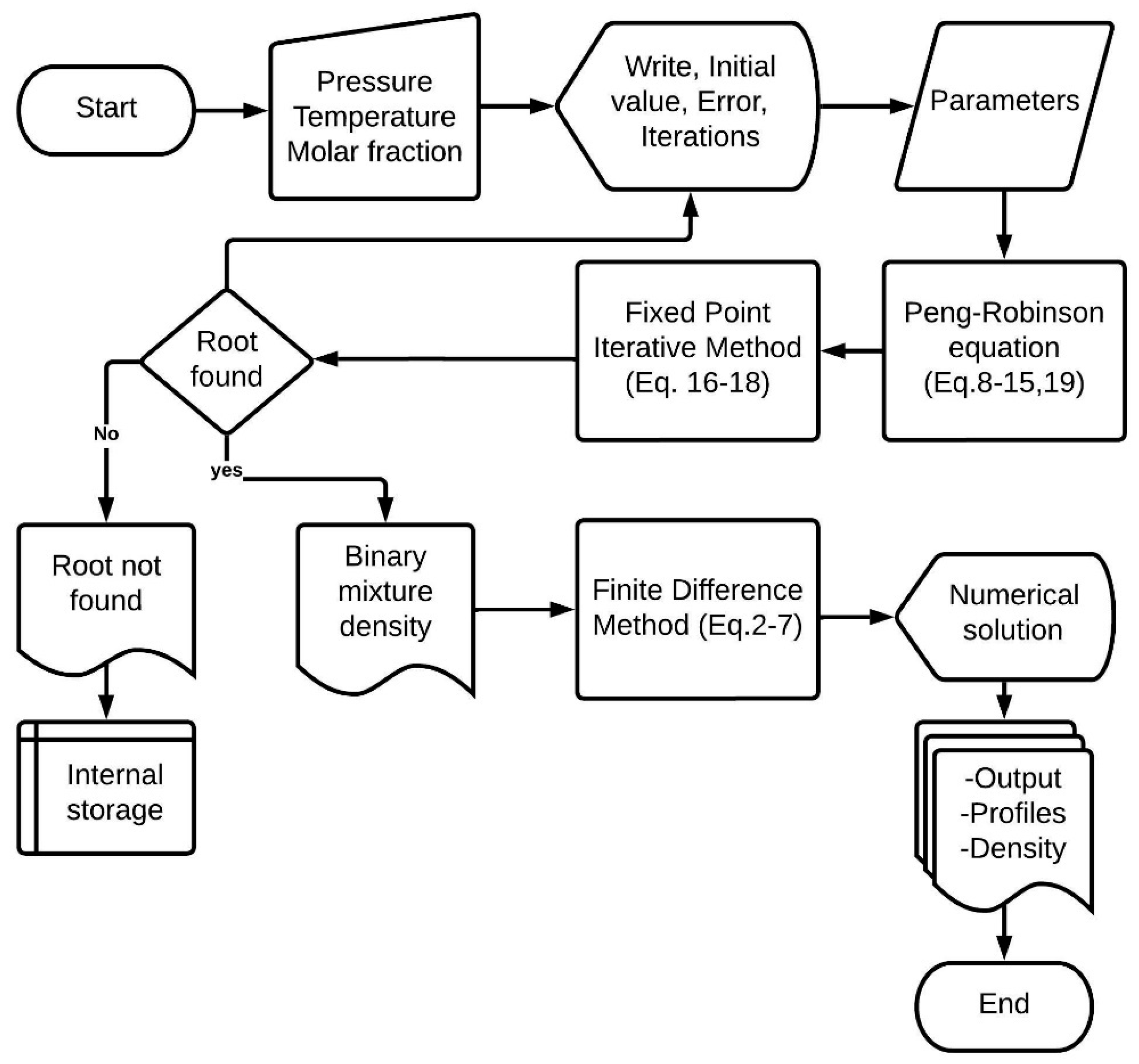
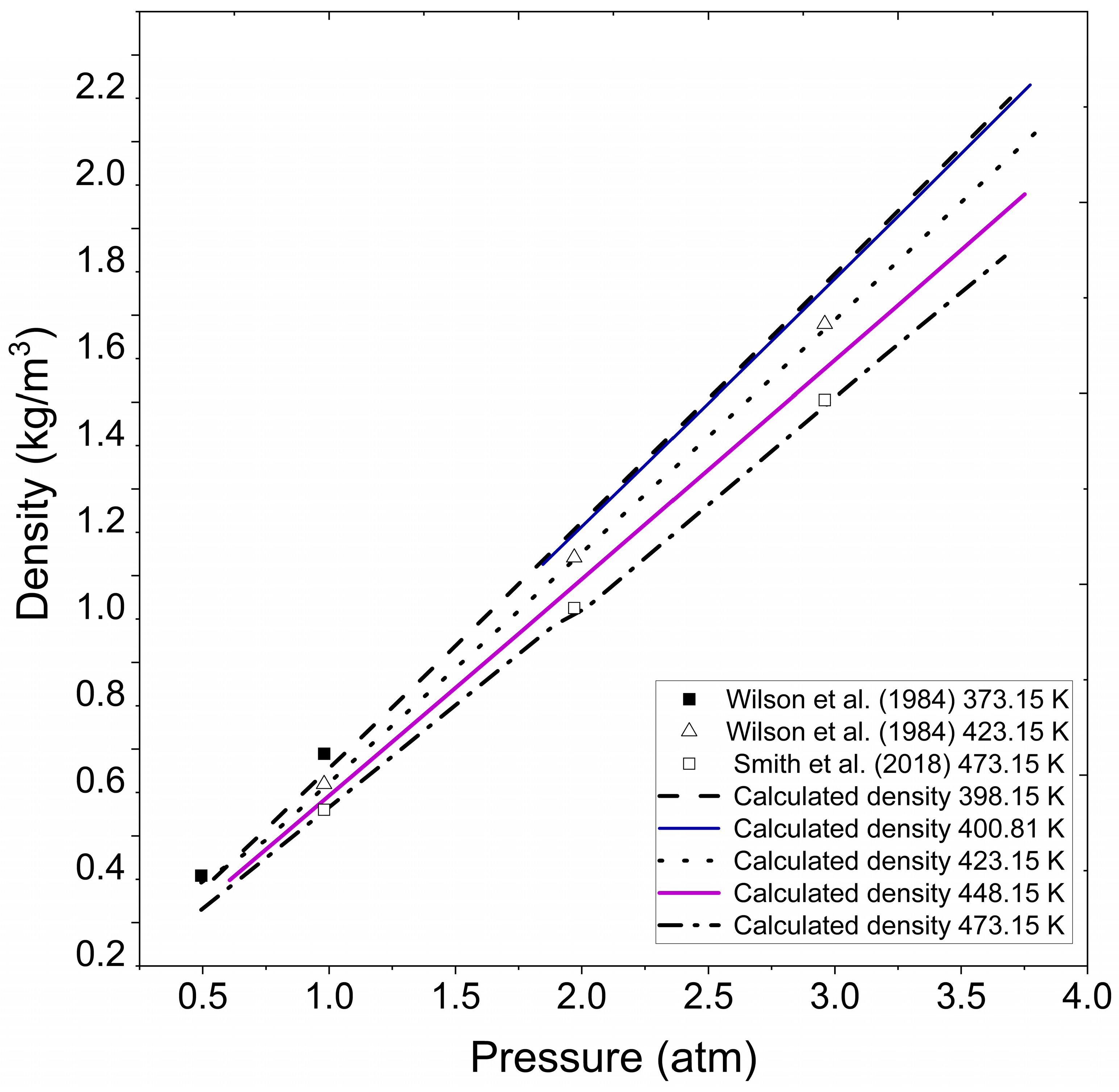

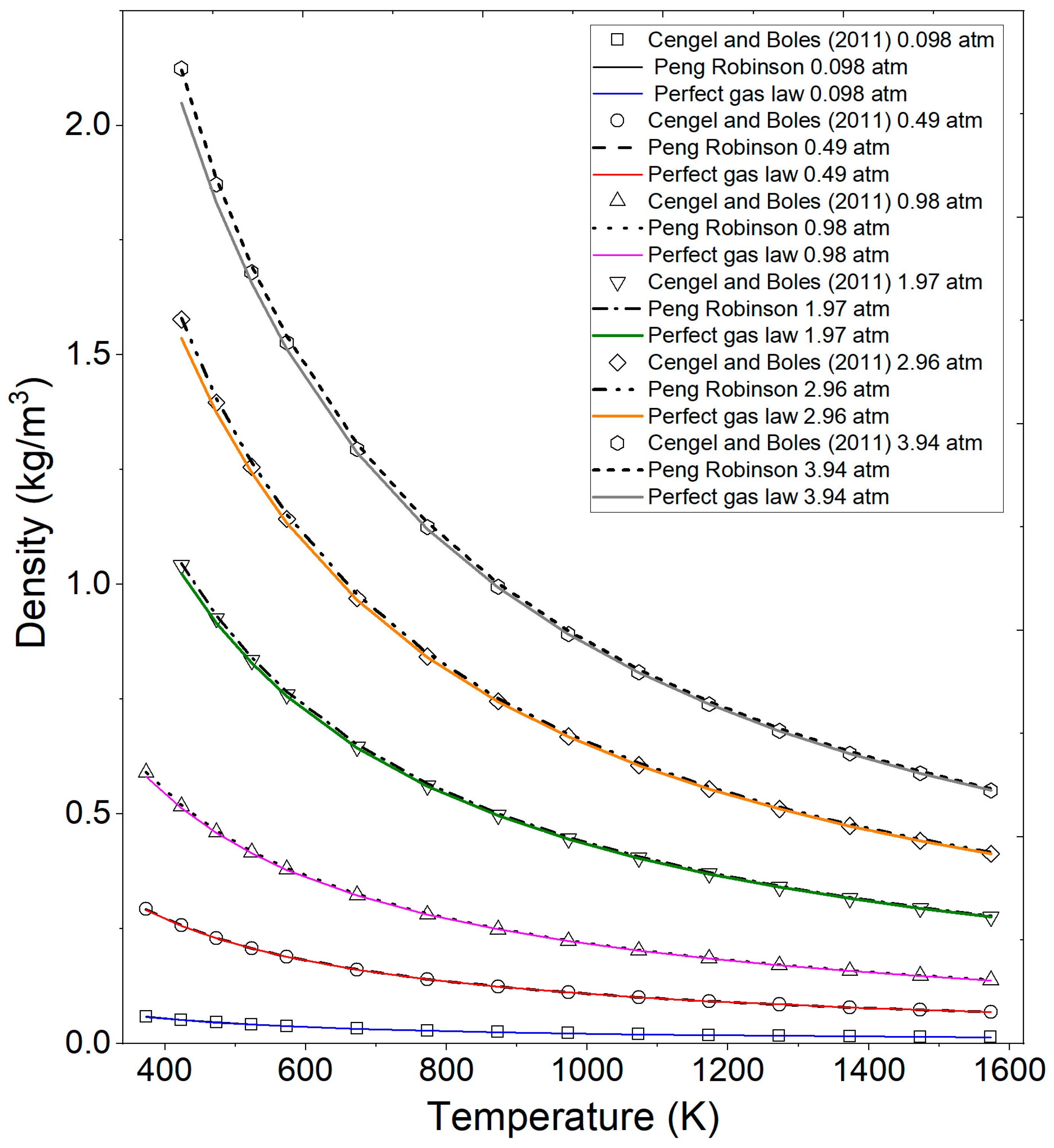


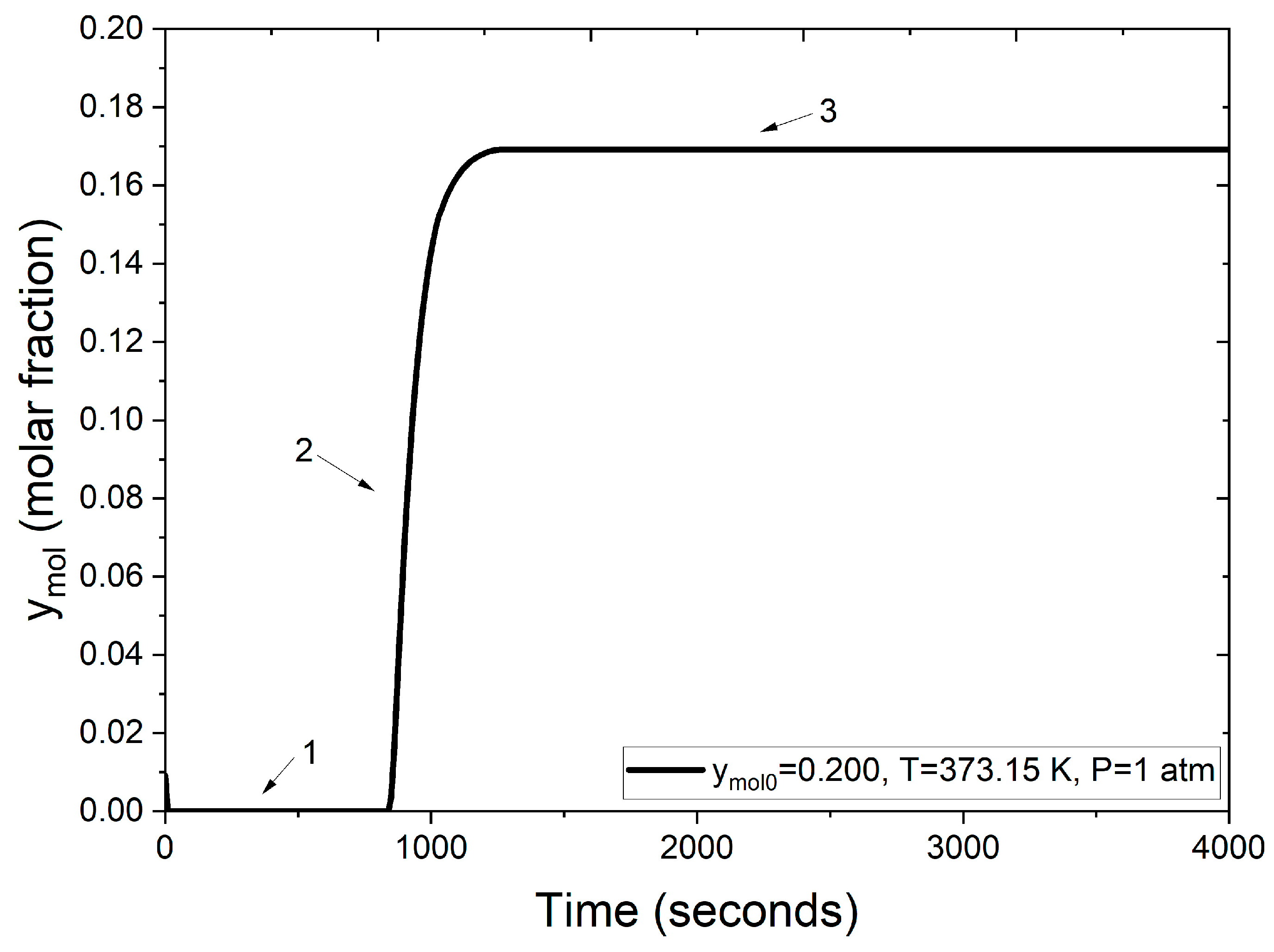
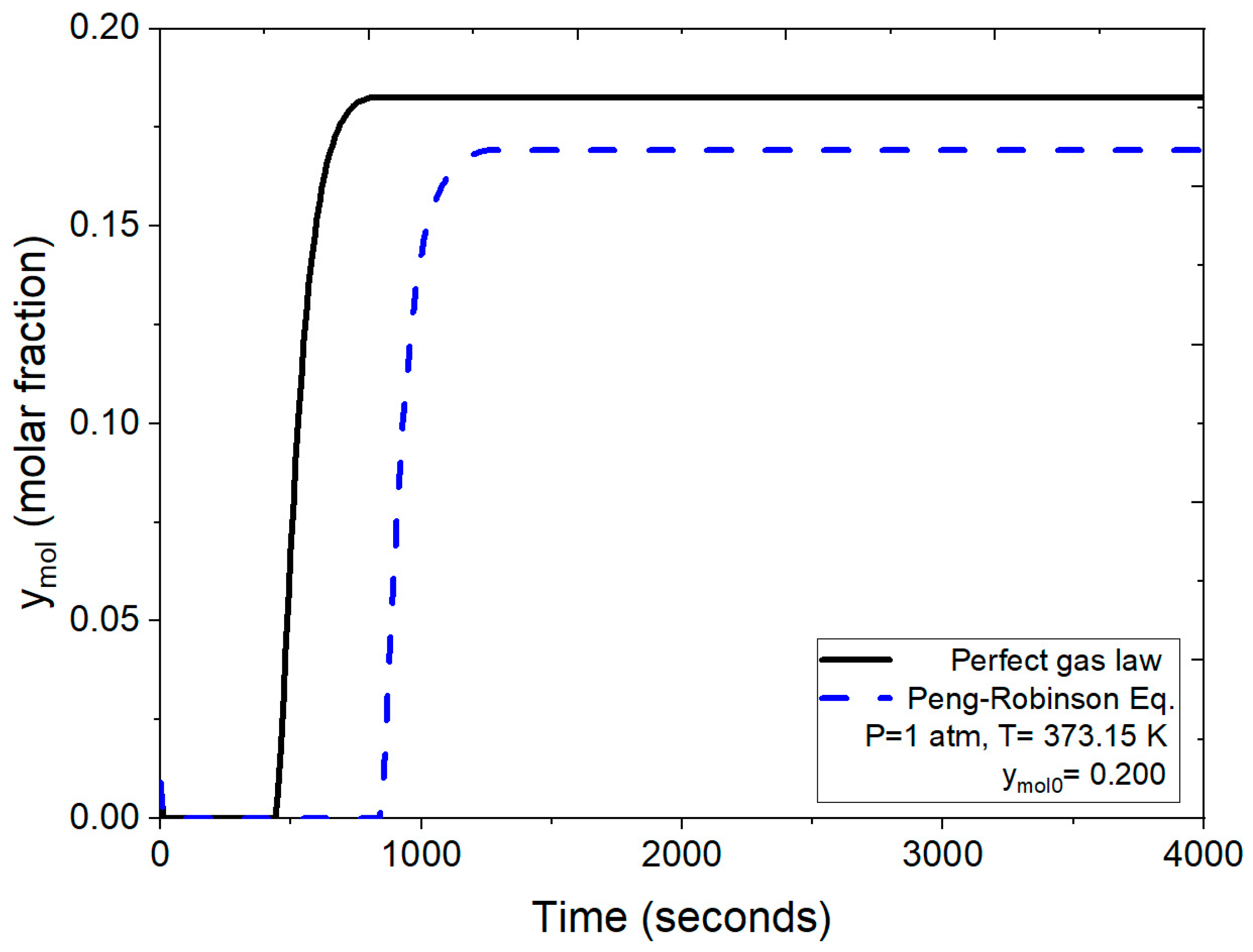
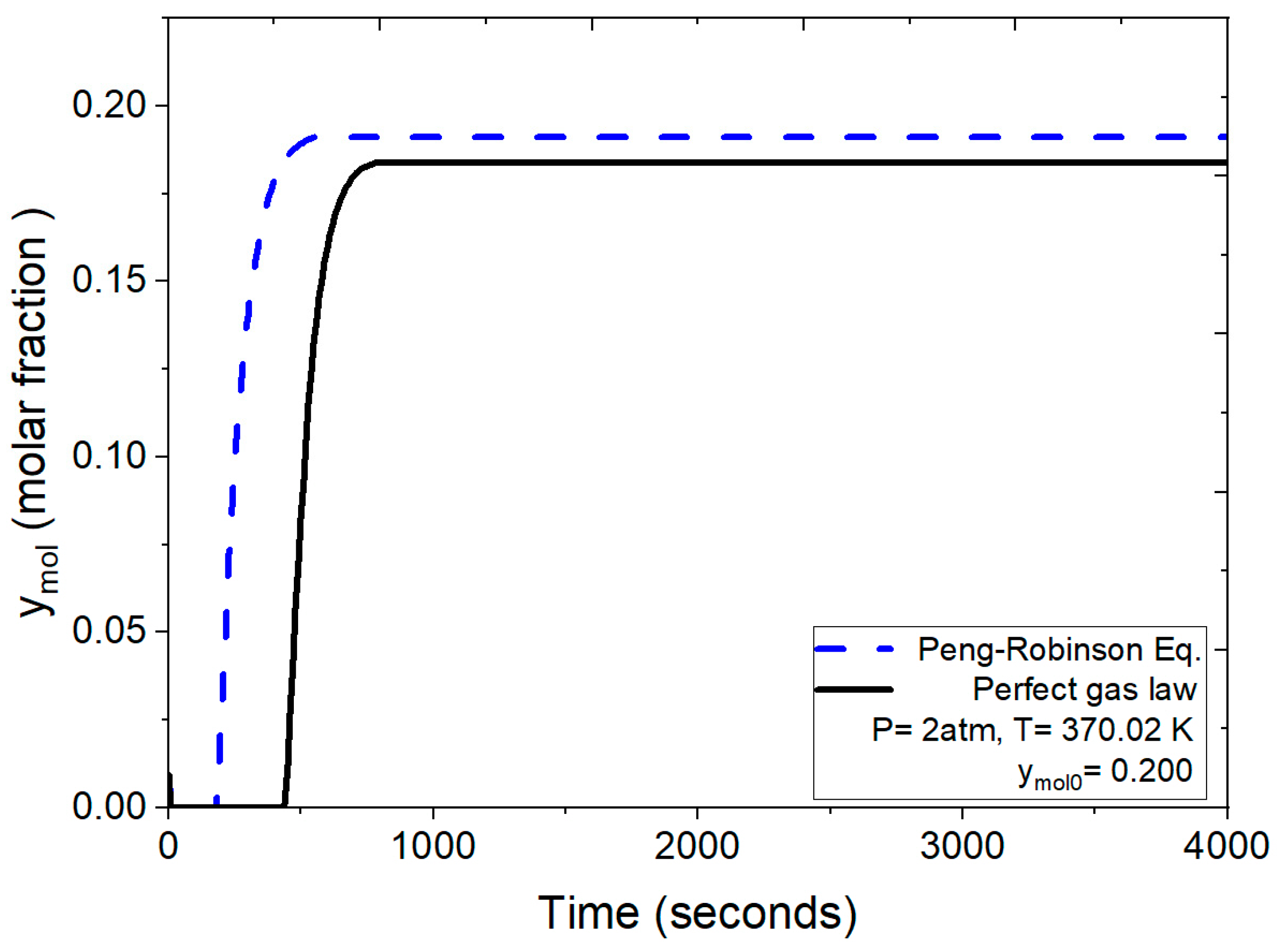
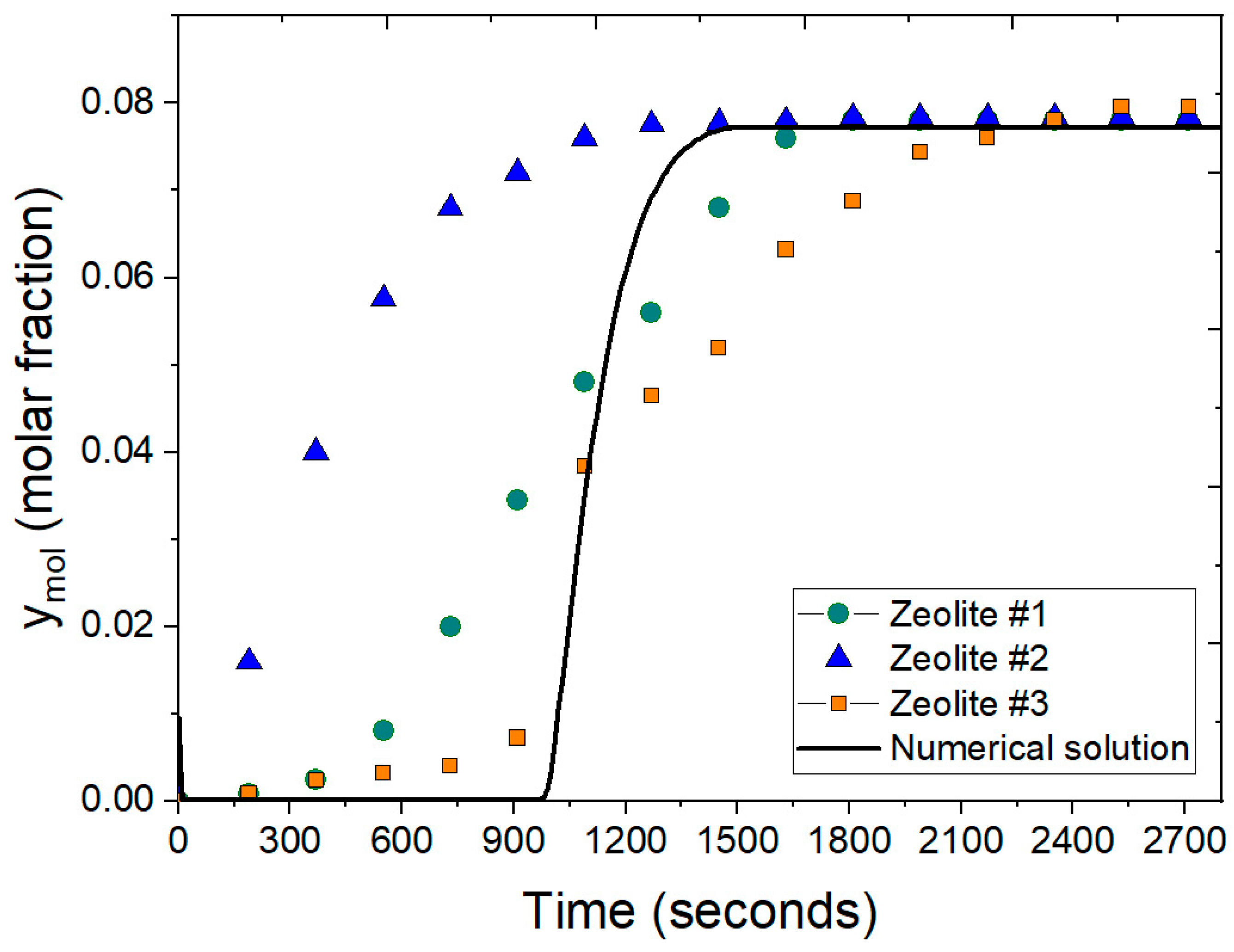
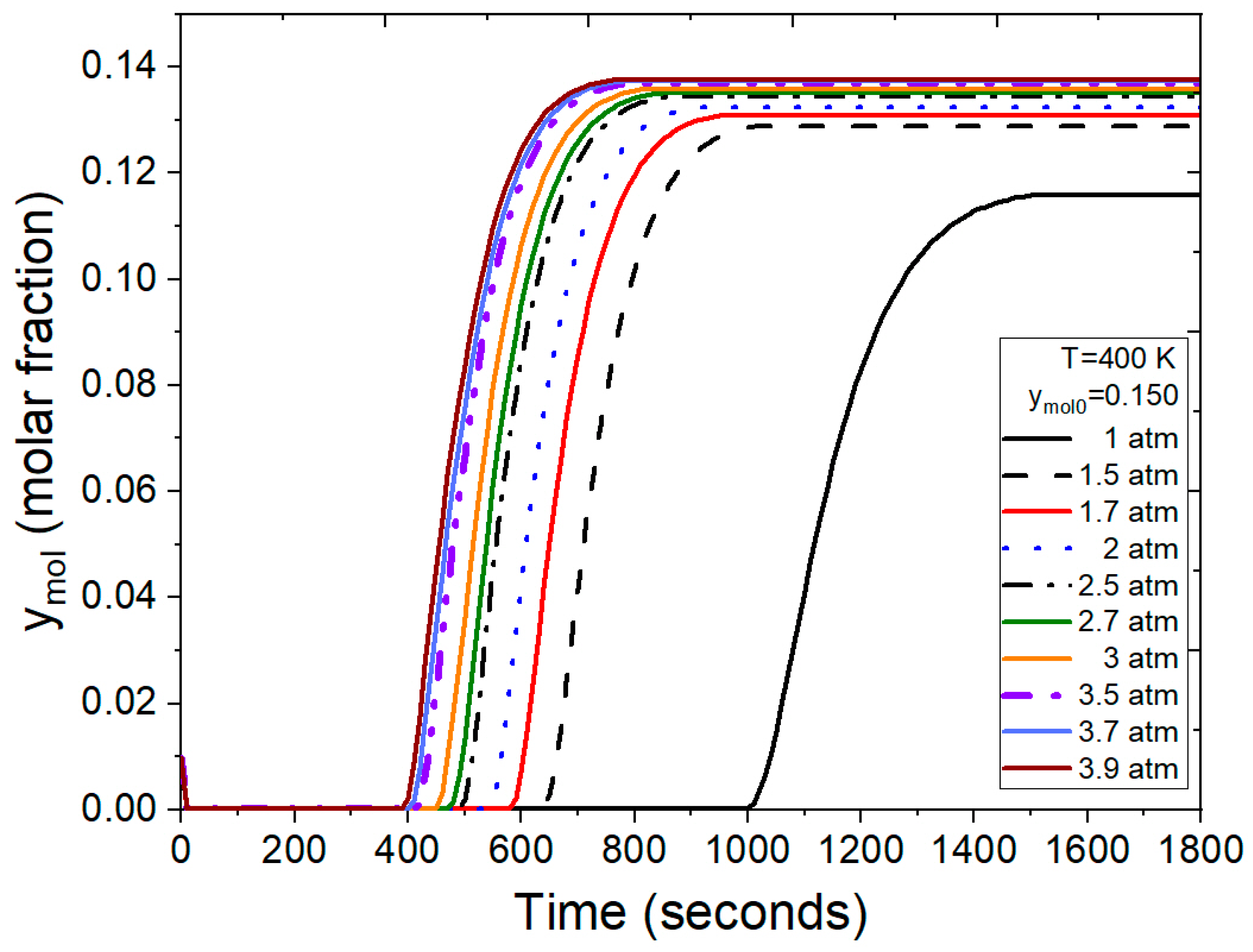
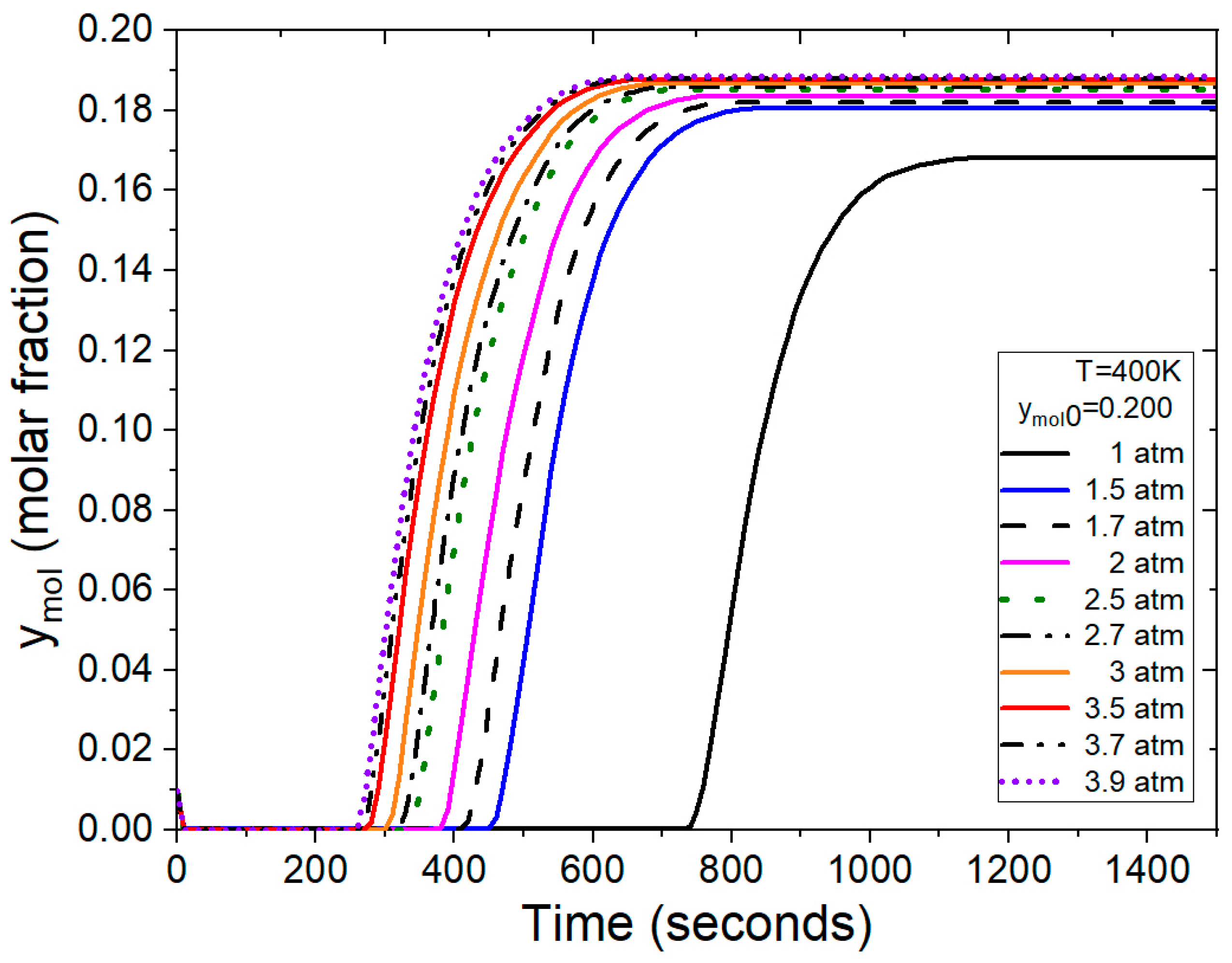
| Molar Weight g/mol | |||||||
|---|---|---|---|---|---|---|---|
| Ethanol | 46.07 | 0.644 | 513.9 | 6.38 | 0.240 | 0.1673 | 351.4 |
| Water | 18.01528 | 0.345 | 647.1 | 22.06 | 0.229 | 0.0560 | 373.2 1 |
| Pressure | 0.098 atm | 0.48 atm | 0.98 atm | |||
|---|---|---|---|---|---|---|
| Temperature (K) | ρ * (kg/m3) | ρ Calculated (kg/m3) | ρ * (kg/m3) | ρ Calculated (kg/m3) | ρ * (kg/m3) | ρ Calculated (kg/m3) |
| 373.15 | 0.058153 | 0.058567 | 0.292509 | 0.291706 | 0.589657 | 0.590651 |
| 423.15 | 0.051248 | 0.051633 | 0.257089 | 0.256890 | 0.516342 | 0.519437 |
| 473.15 | 0.045817 | 0.046168 | 0.229558 | 0.229538 | 0.460320 | 0.463710 |
| 523.15 | 0.041432 | 0.041751 | 0.207443 | 0.207473 | 0.415593 | 0.418874 |
| 573.15 | 0.037813 | 0.038105 | 0.189247 | 0.189291 | 0.378946 | 0.381999 |
| 673.15 | 0.032193 | 0.032441 | 0.161046 | 0.161082 | 0.322300 | 0.324890 |
| 773.15 | 0.028027 | 0.028243 | 0.140178 | 0.140203 | 0.280466 | 0.282690 |
| 873.15 | 0.024816 | 0.025008 | 0.124105 | 0.124122 | 0.248268 | 0.250218 |
| 973.15 | 0.022266 | 0.022437 | 0.111342 | 0.111354 | 0.222717 | 0.224451 |
| 1073.15 | 0.020191 | 0.020346 | 0.100962 | 0.100969 | 0.201943 | 0.203504 |
| 1173.15 | 0.018470 | 0.018612 | 0.092353 | 0.092358 | 0.184717 | 0.186137 |
| 1273.15 | 0.017019 | 0.017150 | 0.085097 | 0.085101 | 0.170198 | 0.171504 |
| 1373.15 | 0.015780 | 0.015901 | 0.078899 | 0.078901 | 0.157798 | 0.159007 |
| 1473.15 | 0.014708 | 0.014821 | 0.073542 | 0.073544 | 0.147085 | 0.148208 |
| 1573.15 | 0.013773 | 0.013879 | 0.068866 | 0.068868 | 0.137732 | 0.138784 |
| Pressure (atm) | 1.97 | 2.96 | 3.94 | |||
|---|---|---|---|---|---|---|
| Temperature (K) | ρ * (kg/m3) | ρ Calculated (kg/m3) | ρ * (kg/m3) | ρ Calculated (kg/m3) | ρ * (kg/m3) | ρ Calculated (kg/m3) |
| 423.15 | 1.041819 | 1.045941 | 1.577237 | 1.579780 | 2.12368332 | 2.1212351 |
| 473.15 | 0.925506 | 0.931998 | 1.395810 | 1.404984 | 1.8714676 | 1.8827926 |
| 523.15 | 0.834098 | 0.840821 | 1.255572 | 1.265899 | 1.68010753 | 1.6941665 |
| 573.15 | 0.759746 | 0.766119 | 1.142400 | 1.152389 | 1.526974 | 1.5408376 |
| 673.15 | 0.645436 | 0.650855 | 0.969415 | 0.977901 | 1.29424707 | 1.3060366 |
| 773.15 | 0.561350 | 0.565953 | 0.842659 | 0.849792 | 1.12440407 | 1.1342088 |
| 873.15 | 0.496766 | 0.500750 | 0.745495 | 0.751598 | 0.99445096 | 1.0027622 |
| 973.15 | 0.445565 | 0.449075 | 0.668539 | 0.673873 | 0.89164705 | 0.89884377 |
| 1073.15 | 0.403959 | 0.407100 | 0.606046 | 0.610788 | 0.80821143 | 0.81456888 |
| 1173.15 | 0.369473 | 0.372319 | 0.554271 | 0.558546 | 0.73910923 | 0.74481845 |
| 1273.15 | 0.340420 | 0.343026 | 0.510663 | 0.514564 | 0.68092524 | 0.68611848 |
| 1373.15 | 0.315609 | 0.318013 | 0.473427 | 0.477020 | 0.63125734 | 0.63602555 |
| 1473.15 | 0.294171 | 0.296406 | 0.441260 | 0.444593 | 0.58835296 | 0.5927698 |
| 1573.15 | 0.275462 | 0.277551 | 0.413191 | 0.416302 | 0.55091562 | 0.5550369 |
| Temperature (K) | Pressure (atm) | ρ 1 (kg/m3) | ρ 2 (kg/m3) | ρ Calculated (kg/m3) |
|---|---|---|---|---|
| 573.15 | 55.889465 | 25.67 | 25.69 | 25.973215 |
| 623.15 | 63.330866 | 25.61 | 25.59 | 26.182194 |
| 673.15 | 70.308414 | 25.55 | 25.52 | 26.166225 |
| 623.15 | 127.21441 | 64.93 | 65.2 | 68.380424 |
| Temperature | 373.07 K | 388.17 K | |||
|---|---|---|---|---|---|
| Pressure (atm) | ρ * (kg/m3) | ρ (kg/m3) | Pressure (atm) | ρ * (kg/m3) | ρ (kg/m3) |
| 1.6847 | 2.6751 | 2.6154 | 1.7520 | 2.6448 | 2.6072 |
| 1.7816 | 2.8428 | 2.7708 | 1.8972 | 2.8667 | 2.8302 |
| 1.8829 | 3.0025 | 2.9342 | 2.0301 | 3.0787 | 3.0351 |
| 1.9916 | 3.1971 | 3.1100 | 2.1820 | 3.3201 | 3.2708 |
| 2.1019 | 3.3825 | 3.2894 | 2.4309 | 3.7207 | 3.6596 |
| 2.1923 | 3.5501 | 3.4370 | 2.7151 | 4.1870 | 4.1076 |
| 2.2821 | 3.7099 | 3.5841 | 3.0850 | 4.8221 | 4.6979 |
| Temperature | 398.15 K | 400.81 K | |||
|---|---|---|---|---|---|
| Pressure (atm) | ρ * (kg/m3) | ρ (kg/m3) | Pressure (atm) | ρ * (kg/m3) | ρ (kg/m3) |
| 0.5441 | 0.7763 | 0.7734 | 1.84619 | 2.68083 | 2.65690 |
| 0.7175 | 1.0252 | 1.0225 | 2.01703 | 2.93178 | 2.91027 |
| 0.9223 | 1.3201 | 1.3183 | 2.24145 | 3.27225 | 3.24518 |
| 1.1335 | 1.6309 | 1.6253 | 2.44751 | 3.58689 | 3.55477 |
| 1.3462 | 1.9462 | 1.9366 | 2.79905 | 4.13703 | 4.08764 |
| 2.7715 | 4.1075 | 4.0765 | 3.32398 | 4.97087 | 4.89477 |
| 3.1165 | 4.6549 | 4.6096 | 3.77341 | 5.71092 | 5.59710 |
| Temperature | 423.15 K | 473.15 K | |||
|---|---|---|---|---|---|
| Pressure (atm) | ρ * (kg/m3) | ρ (kg/m3) | Pressure (atm) | ρ * (kg/m3) | ρ (kg/m3) |
| 0.74491 | 0.99600 | 0.99728 | 0.56066 | 0.66854 | 0.66838 |
| 0.92423 | 1.23774 | 1.24005 | 0.76880 | 0.91398 | 0.91807 |
| 1.11816 | 1.50222 | 1.50380 | 0.99726 | 1.18967 | 1.19314 |
| 1.30379 | 1.75558 | 1.75746 | 1.23136 | 1.46706 | 1.47608 |
| 1.49723 | 2.02106 | 2.02302 | 1.47018 | 1.75732 | 1.76587 |
| 1.68750 | 2.28681 | 2.28550 | 1.71069 | 2.05440 | 2.05889 |
| 2.93800 | 4.02534 | 4.04279 | 1.89149 | 2.27990 | 2.27994 |
Disclaimer/Publisher’s Note: The statements, opinions and data contained in all publications are solely those of the individual author(s) and contributor(s) and not of MDPI and/or the editor(s). MDPI and/or the editor(s) disclaim responsibility for any injury to people or property resulting from any ideas, methods, instructions or products referred to in the content. |
© 2025 by the authors. Licensee MDPI, Basel, Switzerland. This article is an open access article distributed under the terms and conditions of the Creative Commons Attribution (CC BY) license (https://creativecommons.org/licenses/by/4.0/).
Share and Cite
Gutiérrez-González, D.; Luna-Solano, G.; Cantú-Lozano, D.; Aguilar-Uscanga, M.G.; Gómez-Rodríguez, J.; Urrea-García, G.R. Improving Breakthrough Curve Calculations in Dynamic PSA Processes Through a Rigorous Cubic State Equation. Processes 2025, 13, 547. https://doi.org/10.3390/pr13020547
Gutiérrez-González D, Luna-Solano G, Cantú-Lozano D, Aguilar-Uscanga MG, Gómez-Rodríguez J, Urrea-García GR. Improving Breakthrough Curve Calculations in Dynamic PSA Processes Through a Rigorous Cubic State Equation. Processes. 2025; 13(2):547. https://doi.org/10.3390/pr13020547
Chicago/Turabian StyleGutiérrez-González, Daniel, Guadalupe Luna-Solano, Denis Cantú-Lozano, María Guadalupe Aguilar-Uscanga, Javier Gómez-Rodríguez, and Galo Rafael Urrea-García. 2025. "Improving Breakthrough Curve Calculations in Dynamic PSA Processes Through a Rigorous Cubic State Equation" Processes 13, no. 2: 547. https://doi.org/10.3390/pr13020547
APA StyleGutiérrez-González, D., Luna-Solano, G., Cantú-Lozano, D., Aguilar-Uscanga, M. G., Gómez-Rodríguez, J., & Urrea-García, G. R. (2025). Improving Breakthrough Curve Calculations in Dynamic PSA Processes Through a Rigorous Cubic State Equation. Processes, 13(2), 547. https://doi.org/10.3390/pr13020547






